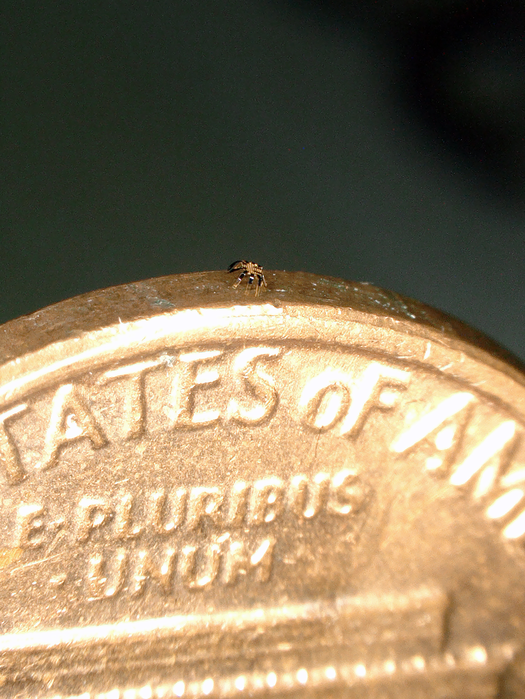Engineers at Northwestern University have created the tiniest-ever remote-regulated walking robot in the form of a miniature, attractive peekytoe crab.
 Smaller than a flea, a single crab robot stands on the edge of a coin. Image Credit: Northwestern University
Smaller than a flea, a single crab robot stands on the edge of a coin. Image Credit: Northwestern University
The miniature crabs, measuring just a half-millimeter in width, can walk, twist, bend, turn, crawl and even jump. The scientists also created millimeter-sized robots that looked like crickets, inchworms and beetles.
Although the study is only in its exploratory phase, the engineers are certain their technology could help take the field a step closer to the realization of micro-sized robots that can carry out practical operations inside compact remote spaces.
The study was published in the May 25th issue of the journal Science Robotics. In September 2021, the same team launched a winged microchip that was the tiniest-ever manmade flying structure (showcased on the cover of Nature).
Robotics is an exciting field of research, and the development of microscale robots is a fun topic for academic exploration. You might imagine micro-robots as agents to repair or assemble small structures or machines in industry or as surgical assistants to clear clogged arteries, to stop internal bleeding or to eliminate cancerous tumors—all in minimally invasive procedures.
John A. Rogers, Louis Simpson and Kimberly Querrey Professor of Materials Science and Engineering, Biomedical Engineering, and Neurological Surgery, McCormick School of Engineering, Northwestern University
“Our technology enables a variety of controlled motion modalities and can walk with an average speed of half its body length per second,” added Yonggang Huang, who led the theoretical work. “This is very challenging to achieve at such small scales for terrestrial robots.”
Rogers led the experimental work. He is a pioneer in bioelectronics and is the Louis Simpson and Kimberly Querrey Professor of Materials Science and Engineering, Biomedical Engineering, and Neurological Surgery at Northwestern’s McCormick School of Engineering and Feinberg School of Medicine and the director of the Querrey Simpson Institute for Bioelectronics (QSIB).
Huang is the Jan and Marcia Achenbach Professor of Mechanical Engineering and Civil and Environmental Engineering at McCormick and a key member of QSIB.
The crab, smaller than a flea, is not driven by intricate hydraulics, hardware, or electricity. Instead, its power comes from inside the elastic resilience of its body. To build the robot, the scientists made use of a shape-memory alloy material that alters to its “remembered” shape when exposed to heat.
Here, the team employed a scanned laser beam to quickly heat the robot at various targeted locations throughout its body. A thin coating of glass elastically returns that equivalent part of the structure to its deformed shape when cooling begins.
As the robot alters from one phase to the next—deformed to remembered shape and back again—it triggers locomotion. The laser remotely regulates the robot to trigger it, and the laser scanning direction establishes the walking direction of the robot. Scanning from left to right, for instance, causes the robot to travel from right to left.
Because these structures are so tiny, the rate of cooling is very fast. In fact, reducing the sizes of these robots allows them to run faster.
John A. Rogers, Louis Simpson and Kimberly Querrey Professor of Materials Science and Engineering, Biomedical Engineering, and Neurological Surgery, McCormick School of Engineering, Northwestern University
To create such a miniature animal, Huang and Rogers turned to a method they presented 8 years ago—a pop-up assembly technique stimulated by a children’s pop-up book.
First, the researchers built precursors to the walking crab structures in flat, planar geometries. Next, they attached these precursors onto a somewhat stretched rubber substrate. When the extended substrate is relaxed, a regulated buckling process takes place that causes the crab to “pop up” into precisely demarcated three-dimensional shapes.
Using this manufacturing method, the Northwestern team could build robots of different sizes and shapes. So what was the reason behind creating a peekytoe crab? We can thank Huang’s and Rogers’ students for that.
With these assembly techniques and materials concepts, we can build walking robots with almost any size or 3D shapes. But the students felt inspired and amused by the sideways crawling motions of tiny crabs. It was a creative whim.
John A. Rogers, Louis Simpson and Kimberly Querrey Professor of Materials Science and Engineering, Biomedical Engineering, and Neurological Surgery, McCormick School of Engineering, Northwestern University
Tiny robotic crab is smallest-ever remote-controlled walking robot
Tiny robotic crab is the smallest-ever remote-controlled walking robot. Video Credit: Northwestern University
Journal Reference:
Han, M., et al. (2022) Submillimeter-scale multimaterial terrestrial robots. Science Robotics. doi.org/10.1126/scirobotics.abn0602.